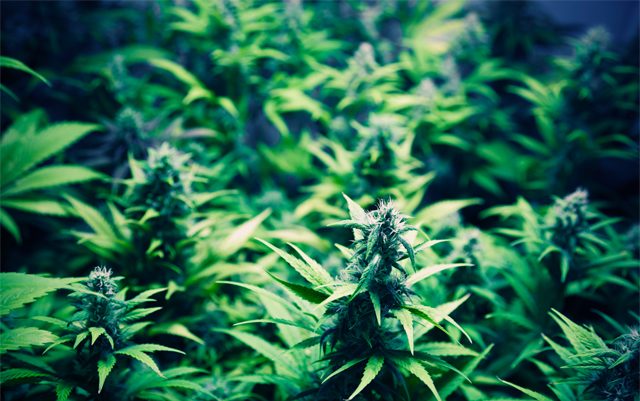I’ve always thought it was impressive how much abuse a marijuana plant can take. I’ve broken branches and burned parts of my plants. I’ve intentionally chopped pieces off and unintentionally left them in the dark for a few days. I’ve over-watered them and under-watered them. But for the most part, they usually recovered just fine.
What about you? What kind of abuse have you intentionally or unintentionally subjected your plants to?
That’s not really what I want to get into today though. Instead, I want to talk about a more gentle process. A way to train your plants to grow in the shape you them to grow in, without causing any sort of physical damage and inducing little to no stress.
What is Low Stress Training?
Low Stress Training, LST from this point on, is a gentle but effective plant training technique. Basically, you bend branches over and tie them down. The end result is a squatter, bushier plant that has multiple colas as opposed to just one main cola. I’ll get into the actual process in a moment, but I want to address something first.
I’m sure most of you already know exactly what I’m talking about and many of you have probably even tried your hand at LST. Chances are though, you just sort of followed a series of photos and tried to emulate what you saw. There’s nothing inherently wrong with doing that, but I feel like learning a little bit more about what you’re doing will make your efforts more worthwhile.
So I’m going to share a little bit of science with you and explain why LST even works and does what it does in the first place. Cool? Cool.
Why Does LST Work?
Let me start by saying that my explanations that follow are very simplified. If you want to take the discussion deeper, let me know in the comments and I’ll be happy to do so.
There are hormones in your plants called auxins. Auxins plays a significant role in several aspects of your plant’s growth. But for the sake of simplicity and staying on topic, we’re only going to explore the role auxins play in regards to LST.
Auxins are concentrated at the apical tip, or shoot, of your plant. The apical tip is the one closest to your light source and auxins tell your plant to focus more of its energy on this part of your plant in terms of growth and development. The apical shoot will always be what is pushed towards the light source and will always have the largest cola.
But what happens when that apical shoot no longer sits above the rest? Auxins get produced further down the stem in attempt to establish a new apical tip.
We’re talking about LST right now, but let’s pause for a minute and point something out. When you top a plant and cut the top shoot off entirely, you have removed the part of your plant that auxins were most concentrated in. The shoots below that are now closest to the light. Auxins become concentrated in these shoots and they compete to become the apical tip. So essentially, topping and fimming is doing the same thing on a biological level as LST.
Alright, moving on.
So when you bend your plant over and tie it down, your plant responds to the fact that it’s top shoot is no longer closest to the light. What then happens is all the shoots down the stem begin competing for that apical position.
Knowing this, you can now understand that LST isn’t just tying your plant down and making it bushier. You’re manipulating the plant’s hormonal system into constantly trying to establish an apical shoot that receives most of the energy for growth and flower development. You do this by keeping all the shoots at about the same height, constantly bringing down the shoot that starts reaching higher than the rest.
How to LST a Marijuana Plant
Just by knowing how and why LST even works, you now know how to effectively LST your marijuana plant. But I do want to tell you about two methods I enjoy using and also answer a few frequently asked questions.
Regardless of the method you decide to use, I recommend starting pretty early — when your plant is about 6 inches tall with 3 to 5 nodes.
Using Stakes for LST
For the first method, you’ll need several U-shaped stakes. You should be able to find them in your local nursery, but if not just make them out of wire. The first time I tried this method, I just used a cut up coat hanger, although I’m not sure I recommend using that due to the plastic coating and all.
The process is super simple and straightforward. All you’re going to do is bend your plant over, loop your stake over the stem and push the ends of the stake into the growing medium. Once the “top” of your plant has grown out a little, move the stake up the stem and pin it back down. Ultimately, you’re going to guide your plant around the perimeter of your pot in a curved shape.
All the while you’re keeping an eye on the other shoots along the length of the stem.
Remember, the goal is to keep everything level. Once a shoot begins to reach further than the rest, bring it back down with one of your stakes.
I really liked this method and it worked quite well for me, but I eventually ditched it for two reasons. First, I was paranoid that I would damage the roots of my plant when shoving the stakes down. But it was mostly because the stakes wouldn’t reliably hold in the soil. They would either slide right back out immediately or hold for a little while and then come loose.
Using String for LST
This method takes a little bit more work, but it is so worth it. You’re going to need a spool of string, like twine or hemp, and either a thick rubber band that will fit over your pot or a box of small eye bolts or screws. Personally I prefer using the eye bolts; I’ll explain why in a moment.
If you decided to go with a rubber band, just stretch it over the top of the pot and you’re good to go.
What you’re going to do with the eye bolts is screw them into your pot along the outside of the top of your pot. If you have the patience, space them about a quarter of an inch apart. You could get away with spacing them about an inch apart though, maybe even a little more. I just prefer having multiple tie off points, but do what you’re comfortable with.
The hormones in your marijuana plant haven’t changed, so the process is the exact same as the one above. Train the “top” of your plant around the pot while keeping all the other shoots level. But instead of anchoring your plant down with stakes, you’re going to secure one end of a piece of string to the pot, thread the other end over the stem of the shoot you’re tying down, pull the string taut and secure it on the other side of the pot.
I prefer using the eye bolts for this method for a couple of reasons.
One, rubber bands can and will break on you. Those eye bolts aren’t going anywhere. Two, you’ll inevitably, but unintentionally, release strings as you pull the rubber band out to secure a different string. With the eye bolts, you just tie each end of the string and that’s that, it won’t be coming undone.
FAQs About LST
Can every strain of marijuana be LST’d?
Yes, although like any other aspect of growing, some strains respond better to it than others.
Can I combine LST with other types of training?
Absolutely! LST works very well when paired with fimming and topping. I’m a fan of combining LST with defoliation, or removing leaves (ask me about it in the comments) as well.
Does LST really result in a bigger yield?
Man, this is debatable. What you’re doing with LST is dividing the energy that would be spent on one apical stem amongst several. Most agree that it shouldn’t result in a larger harvest, but it seems to for some people, myself included. Regardless, you get to enjoy several fully developed colas as opposed to one cola, a couple nice ones and then a bunch of popcorn buds.
Do I continue LST through the flowering cycle?
Yes, but you should really only have to through the stretch. After that, everything should remain fairly even.
—
That’s it for today guys. But like always, feel free to meet me in the comments section and talk about this further. Where my lollipoppers at? I know you guys want to chime in on this one. For those of you that don’t know, lollipopping is kind of like the opposite of LST. Most of the lower growth is stripped away so the plant can focus on developing its single top cola. To each their own, I suppose.






